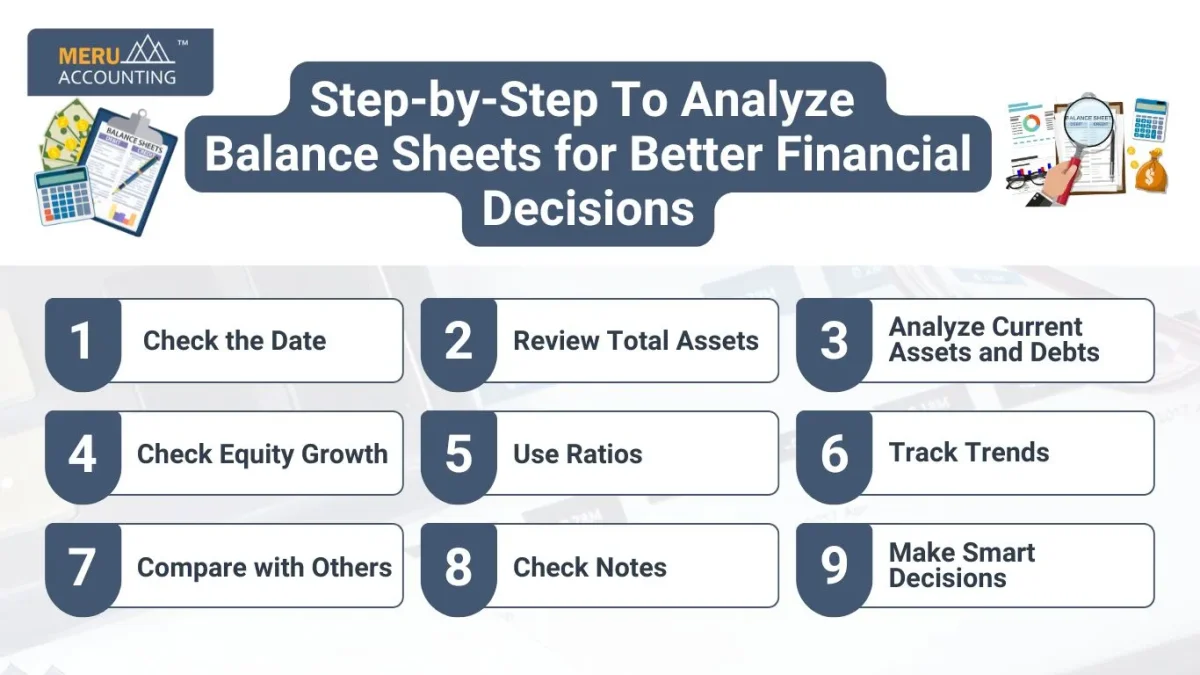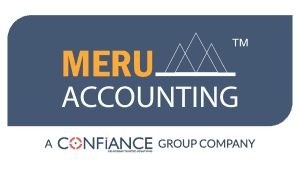How to Analyze Balance Sheets for Better Financial Decisions
A balance sheet is a report that shows what a business owns and owes. Reading balance sheets helps owners and investors check the health of a company. It lists assets, debts, and owner equity in a clear way. Knowing how to read a balance sheet helps you make smart money choices.
Analyzing balance sheets shows trends in money, debts, and profits. It helps plan budgets, control risks, and grow business safely. By learning to read and study balance sheets, you can spot problems early. This guide explains easy steps to analyze balance sheets and make better decisions.
What is a Balance Sheet?
- A balance sheet shows the money a business has and owes.
- It is a report for a specific day or month.
- It always follows the rule: Assets = Liabilities + Equity.
- This ensures the books are correct and the numbers match.
Main Parts of a Balance Sheet
- A balance sheet has three parts: assets, debts, and equity.
- Assets show what the business owns. Debts show what it owes.
- Equity is the owner’s share of the business.
- Reading balance sheets helps see all parts clearly.
Key Parts of a Balance Sheet
Assets: Things the Company Owns
- Assets are things a business uses to earn money.
- They are split into current and non-current assets.
- Current assets include cash, stock, and money owed by others.
- Non-current assets include land, buildings, and equipment.
- Checking assets shows how strong and ready a business is.
Liabilities: What the Company Owes
- Liabilities are debts a company must pay.
- They include current debts and long-term debts.
- Current debts are bills, wages, or short-term loans.
- Long-term debts are loans, bonds, or rent for years.
- Studying debts shows whether a business can pay on time.
Equity: Owner’s Share
- Equity is the value left for owners after debts.
- It includes profits kept and money invested by owners.
- Positive equity shows a healthy business.
- Low or falling equity may show losses or poor money use.
- Equity study helps plan growth and new investments.
How to Read Balance Sheets
Check Assets First
- Reading balance sheets at this stage helps identify which assets are strong and which may need attention.
- Compare current assets with current debts for short-term strength.
- Find which assets are easy to convert to cash.
- Track changes in stock, money owed, and cash flow.
Review Debts Carefully
- Reading balance sheets shows if the business can manage debts without stress.
- High debts compared to assets may mean risk.
- Ensure the business can pay all debts on time.
- Watch trends in loans and bills to plan better.
Study Equity
- Look at profits kept in the business over time.
- Higher equity usually shows strong profit and control.
- Lower equity may show poor spending or losses.
- Equity review helps plan future funds and growth.
Use Ratios to Learn More
- Ratios make reading balance sheets simpler and clearer.
- Current ratio, debt-to-equity, and ROE are very helpful.
- Ratios show liquidity, risk, and profit in simple ways.
- They allow fast checks without reading all the numbers.
Current Ratio
- Current Assets ÷ Current Liabilities shows short-term health.
- A number above 1 means the business can pay its debts.
- A low number may show cash flow problems or risk.
Debt-to-Equity Ratio
- Total Debts ÷ Equity shows the money risk from loans.
- A high ratio means more loans and higher risk.
- A low ratio means low debt and a safer money position.
Return on Equity (ROE)
- Net Profit ÷ Equity shows profit per owner’s money.
- Higher ROE means money is used well to earn profit.
- Investors use this to check business efficiency and growth.
Tips for Analyzing Balance Sheets
Compare Over Time
- Study past balance sheets for trends in assets and debts.
- Look at cash flow and profits over months or years.
- Consistent growth shows good money management.
- Falling numbers may show problems that need fixing.
Compare with Other Businesses
- Benchmark against similar companies in the same field.
- Compare assets, debts, and profits to find strengths and weaknesses.
- Spot areas where your business can improve.
- Use this to guide smart business and money plans.
Watch for Red Flags
- Large unpaid debts or falling cash are warning signs.
- High stock with low sales may show inefficiency.
- Rapid growth without profit may be risky.
- Early detection avoids bigger money problems.
Check Liquidity
- Make sure cash and quick assets cover short-term debts.
- Poor liquidity can stop daily operations or loan repayment.
- A balance sheet study shows if money is enough for needs.
- Regular checks keep the business safe from cash issues.
Read Notes
- Notes explain unusual numbers or special debts.
- They give details not visible in the main numbers.
- Notes often show risk or one-time events.
- Reading notes ensures correct money decisions.
Step-by-Step To Analyze Balance Sheets for Better Financial Decisions
Check the Date
- Know the day or month the balance sheet is for.
- Match it with other financial reports for clarity.
Review Total Assets
- Compare assets with debts to see the money strength.
- Focus on main asset types like cash and stock.
Analyze Current Assets and Debts
- Make sure short-term debts can be paid.
- Compare cash, stock, and money owed for safety.
Check Equity Growth
- Higher equity shows profits are kept in the business.
- Falling equity shows money issues needing attention.
Use Ratios
- Current ratio, debt-to-equity, and ROE give clear insight.
- Ratios allow quick checks without long calculations.

Track Trends
- Reading balance sheets over time makes spotting shifts in money or debt simple and clear.
- Identify areas needing attention or improvement.
Compare with Others
- Benchmark with similar companies to spot gaps.
- Helps plan money and operations better.
Check Notes
- Look at explanations of unusual numbers or debts.
- Notes show details needed for safe money decisions.
Make Smart Decisions
- Use insights to plan budgets, investments, and loans.
- Balance sheet review guides short and long-term growth.
Understanding Different Types of Balance Sheets
Classified Balance Sheet
- A classified balance sheet splits assets and debts into short-term and long-term.
- It makes the sheet easy to read.
- Current assets include cash, stock, and money owed by customers.
- Long-term assets include land, machines, and buildings.
- Small and big firms use this type.
- It shows the financial state at a glance.
Comparative Balance Sheet
- A comparative balance sheet shows two or more periods side by side.
- It makes growth or fall easy to see.
- Assets, debts, and owners’ funds can be compared.
- It shows trends in profit, cash, and loans.
- It also shows changes in firm plans over time.
Common-Size Balance Sheet
- A common-size balance sheet shows assets, debts, and equity as a share of total assets.
- It is easy to compare firms of different sizes.
- It shows which assets or debts take up more space.
- Investors and managers can study the finances.
- It helps spot odd changes in money or debts.
Key Indicators for Balance Sheet Analysis
Working Capital
- Working capital = Current Assets − Current Liabilities.
- It shows if a firm can pay short-term debts.
- Positive working capital means enough cash.
- Negative working capital may show cash problems.
- Tracking it over time shows if the firm is stable.
Quick Ratio
- Quick ratio = (Cash + Receivables) ÷ Current Liabilities.
- It shows if debts can be paid without selling stock.
- A high ratio means strong short-term health.
- A low ratio may show money tied up in stock.
- Compare it with peers to see the firm’s strength.
Debt Coverage
- Debt coverage shows if the firm earns enough to pay its debts.
- It is found by comparing net profit or cash with total loans.
- A high ratio means low risk for lenders.
- A low ratio shows possible stress.
- Checking it often can prevent money problems.
Industry-Specific Balance Sheet Insights
Retail Business
- Stock is a big part of assets.
- High stock may show overbuying or slow sales.
- Cash and receivables need to be watched.
- Debt should not exceed cash from sales.
- Seasonal changes must be kept in mind.
Service Business
- Cash and receivables matter more than stock.
- Low fixed assets cut risk.
- Debt must be handled well.
- Retained profit grows owners’ funds.
- Fast billing and collection keep cash strong.
Manufacturing Business
- Firms spend a lot on machines and buildings.
- Stock and work-in-progress add to current assets.
- Liabilities may include big loans or vendor payables.
- Watch trends in assets and debts.
- Efficient work and stock control affect finances.
Common Mistakes in Balance Sheet Analysis
- Ignoring small accounts can lead to big issues.
- Comparing firms of different sizes without % is wrong.
- Notes show special debts or pending bills.
- Numbers alone may hide risk; watch the market.
- Old or wrong entries can distort results.
Advanced Tips for Business Owners
- Track ratios like current ratio, debt-to-equity, and ROE often.
- Use software to make sheets fast and correct.
- Check pending taxes or fines to avoid surprises.
- Link the balance sheet with the profit and loss for a full view.
- Review sheets with your team to plan growth and cut risk.
Analyzing balance sheets is key to smart money decisions. Reading balance sheets reveals strengths, weaknesses, and risks clearly. Meru Accounting offers expertise in interpreting financial statements with clarity. We use ratios, trends, and notes to make the process simple and actionable. Our team drives improvements in cash flow, profits, and financial planning for steady growth. Partnering with Meru Accounting gives business owners clear insights and the confidence to make safer financial decisions.
FAQs
- What is a balance sheet?
It is a report showing assets, debts, and owner equity. - Why read balance sheets?
It helps check money health and make smart choices. - What are current assets?
Things that turn into cash in a year, like stock. - What is equity?
Owner’s share left after all debts are paid. - How do ratios help?
Ratios show cash health, risk, and profit quickly. - What are red flags?
Falling cash, high debt, or low equity show risk. - How often to check balance sheets?
At least every quarter to track business money safely.








